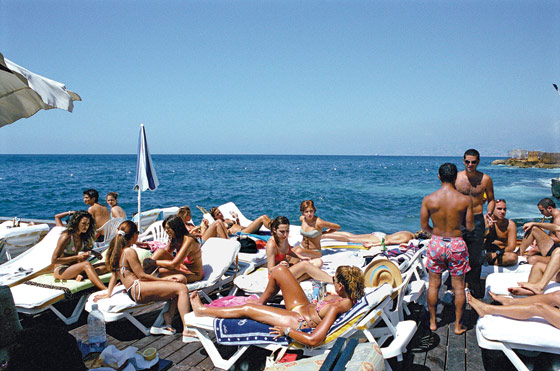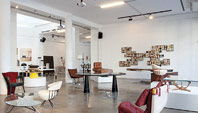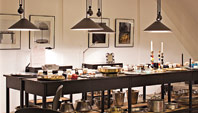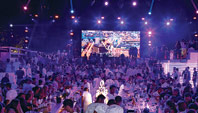
“Paris of the Middle East”?
Ever since Lebanon gained independence from France in 1943, no moniker has stuck to Beirut more persistently. But is it rightful praise or a pathetic cliché? “Our nightlife rocks, our fashion is constantly up to date, we make kick-ass wine, and French is our second language,” enthuses Yasmina Abi Rafeh, the owner of a construction company. Bilal Annan, a Lebanese graduate student in Paris, is less captivated. “To my mind this expression epitomizes the pervasive impression of inferiority, envy, and unfulfillment that a portion of Lebanese people get when they compare their culture to Western ones,” he says ruefully.
Love or loathe the phrase, a palpable French influence permeates the city: For a fully Gallic day, pick up a copy of L’Orient Le Jour newspaper (lorientlejour.com) and flip through it over a vanilla éclair at the Paul boulangerie (Ave. Georges Haddad, Gemmayzeh; paul.fr). Do your afternoon shopping for designer threads at Zadig & Voltaire (2 Park Ave., downtown; zadig-et-voltaire.com), and then grab macarons at Ladurée (128 Rue Foch; laduree.fr), a nice prelude to a steak dinner at Le Relais de l’Entrecôte (Rue Abdel Wahab El Inglizi; relaisentrecote.fr). Come nightfall, there are French-language performances to take in at Théâtre Monnot (Rue de l’Universite St. Joseph, Ashrafiyeh) and cocktails to be swigged in the swank Behind the Green Door (Rue Gemmayzeh, Mar Mikhael), inspired by Paris’s famous Le Mathis bar.
Choose Your Own Adventure
Gallery-Hopping
Where: The Qarantina district, a once-violence-stricken industrial backwater that’s now emerging as the Chelsea of Beirut.

The area was pioneered in 2005 by the renowned Galerie Sfeir-Semler (Tannous Building), making it a good jumping-off point for an art tour. The sister to the main gallery in Hamburg and a bridge between Western and Middle Eastern contemporary art, it exhibits renowned artists from the post–civil-war generation like Walid Raad and Marwan Rechmaoui. Opened just last year by genius architect Gregory Gatserelia, SMO Gallery (Dagher Building) deals mainly in furniture and installations, with some photography. It’s one of the first of its kind in the country. The new Art Factum Gallery (Rehban St., Alley 204, Building 13), on the other hand, is a large contemporary space that introduces emerging and mid-career international and local artists like Naiza Khan, Go Segawa, and Tanya Traboulsi. —Lea Sednaoui, director, The Running Horse gallery
Shopping
Where: The up-and-coming Port Beirut neighborhood.

The seriously fashionable should begin at Rabih Kayrouz (Fayyad Building, Rue Darwish Haddad). The architecture-influenced designer shows at Paris Fashion Week, but this is one of his few namesake boutiques. Next door, Karen Chekerdjian’s housewares-and-furniture showroom marries minimalist design with traditional Lebanese workmanship. Artisans du Liban et d’Orient (Ain Mreisseh) curates select Lebanese décor and clothing, while Joanna Dahdah (Hermitage Building, Ghandour el Saad St.) sells her silver- and gold-plated jewelry alongside other designers’ pieces. And for a distinctly Lebanese purchase, swing by Ashekman Urban Wear (Strand Building, Hamra St.), established by graffiti artists who combine their graphic-design studies and passion for hip-hop in T-shirts that mix Arabic graffiti, urban graphics, and calligraphy. —Tala Hajjar, co-founder, the Starch Foundation for emerging designers
Partying
Where: All over; this is the city of a thousand nightclubs.

Right now, the biggest draw for Beirut night owls are rooftops like White (Seaside Road, Daoura), a massive open-air nightclub with a revolving door of international D.J.’s, and Coop d’Etat (Pasteur St., Gemmayzeh), which is more casual and has both a diverse crowd and a diverse lineup of bands and deck-manners. At the Berlin-style Dictateur (30 Bedawi Street), there’s an underground vibe with raw walls and ahead-of-the-curve revelers, while the all-white L’Osteria (Tyan Building, Armenia St., Mar Mikhael) is more Franco-Italian, serving wine and charcuterie to a jazz soundtrack. MYU (Mar Antonios St., Gemmayzeh) is a nice dining spot, but at the end of the night, lights go down and serious on-top-of-the-bar dancing begins. And nearby at the more approachable Demo (Rue du Liban, Gemmayzeh), the music is kept at a volume that welcomes conversation among tourists and locals.—Laila Sarkis, a.k.a. Djette, local D.J.